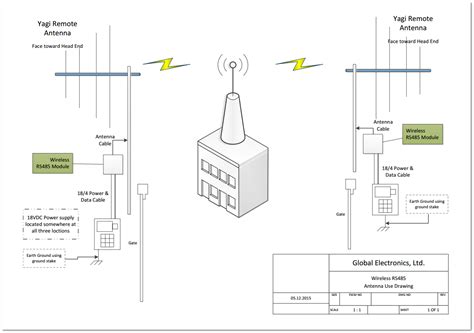What is RS485?
RS485, also known as TIA-485-A, is a standard defining the electrical characteristics of drivers and receivers for use in serial communications systems. It is a balanced line, half-duplex transmission system that allows multiple transmitters and receivers on a single twisted pair cable. RS485 is widely used in industrial automation, building automation, and other applications requiring reliable, long-distance data transmission.
Key Features of RS485
-
Differential Signaling: RS485 uses differential signaling, which means that the data is transmitted using two wires, each carrying an equal but opposite signal. This helps to cancel out electromagnetic interference (EMI) and ensures a more robust and error-free data transmission.
-
Long Distance Transmission: RS485 can transmit data over distances up to 1200 meters (4000 feet), making it suitable for large-scale industrial installations and building automation systems.
-
Multi-Drop Network: RS485 supports multi-drop networks, allowing multiple devices (up to 32) to be connected on a single bus. This makes it easy to expand the network and add new devices as needed.
-
High Data Rates: RS485 can support data rates up to 10 Mbps, depending on the cable length and quality. This is sufficient for most industrial applications, such as process control, monitoring, and data acquisition.
Wireless Communication Technologies
Wireless communication technologies have gained significant traction in recent years, offering a range of benefits over traditional wired systems. Some of the most popular wireless technologies include:
Wi-Fi (IEEE 802.11)
Wi-Fi is a wireless networking technology that uses radio waves to provide high-speed internet and network connections. It operates in the 2.4 GHz and 5 GHz frequency bands and offers data rates up to several Gbps, depending on the standard (e.g., 802.11ac, 802.11ax).
Bluetooth
Bluetooth is a short-range wireless communication technology that operates in the 2.4 GHz frequency band. It is primarily used for connecting devices such as smartphones, headphones, and peripherals. Bluetooth offers data rates up to 2 Mbps (Bluetooth Classic) or 24 Mbps (Bluetooth 5.0).
Zigbee (IEEE 802.15.4)
Zigbee is a low-power, low-data-rate wireless mesh network standard designed for applications such as home automation, industrial control, and sensor networks. It operates in the 2.4 GHz, 915 MHz, and 868 MHz frequency bands and offers data rates up to 250 kbps.
LoRaWAN
LoRaWAN (Long Range Wide Area Network) is a low-power, long-range wireless communication protocol designed for Internet of Things (IoT) applications. It operates in the sub-GHz frequency bands and can transmit data over distances up to 10 km in rural areas and 1-2 km in urban environments.

RS485 vs Wireless: Comparison
| Feature | RS485 | Wireless Technologies |
|---|---|---|
| Transmission | Wired (twisted pair) | Wireless (radio waves) |
| Distance | Up to 1200 m | Varies (Wi-Fi: ~100 m, Bluetooth: ~10 m, LoRaWAN: ~10 km) |
| Data Rate | Up to 10 Mbps | Varies (Wi-Fi: up to Gbps, Bluetooth: up to 24 Mbps, Zigbee: 250 kbps) |
| Power Consumption | Low | Varies (Wi-Fi and Bluetooth: higher, Zigbee and LoRaWAN: lower) |
| Interference | Less susceptible (differential signaling) | More susceptible (shared frequency bands) |
| Network Topology | Multi-drop bus | Various (star, mesh, point-to-point) |
| Security | Less vulnerable (wired) | More vulnerable (wireless) |
Advantages of RS485
-
Reliability: RS485’s differential signaling and wired transmission make it less susceptible to electromagnetic interference and more reliable than wireless technologies.
-
Distance: RS485 can transmit data over longer distances compared to most wireless technologies, making it suitable for large-scale industrial installations and building automation systems.
-
Security: Wired systems like RS485 are inherently more secure than wireless systems, as they are not vulnerable to over-the-air attacks and eavesdropping.
Advantages of Wireless Technologies
-
Flexibility: Wireless technologies offer greater flexibility in terms of device placement and network expansion, as they do not require physical wiring.
-
Mobility: Wireless devices can be easily moved and repositioned, making them suitable for applications that require frequent changes in layout or device locations.
-
Cost: In some cases, wireless systems can be more cost-effective than wired systems, as they eliminate the need for extensive cabling and associated installation costs.

Future Prospects
Despite the increasing popularity of wireless communication technologies, RS485 is likely to remain a relevant and widely used standard in the foreseeable future. This is due to its inherent advantages in terms of reliability, distance, and security, which are critical factors in many industrial and building automation applications.
However, it is also expected that wireless technologies will continue to evolve and improve, offering better performance, reliability, and security. In some cases, wireless technologies may be used in conjunction with RS485, creating hybrid systems that leverage the strengths of both wired and wireless communication.

Frequently Asked Questions (FAQ)
-
Q: Can RS485 and wireless technologies coexist in the same system?
A: Yes, RS485 and wireless technologies can coexist in the same system. In fact, many modern systems use a combination of wired and wireless technologies to achieve the best balance of performance, reliability, and flexibility. -
Q: Is RS485 still relevant in the age of wireless communication?
A: Yes, RS485 remains relevant in many industrial and building automation applications due to its reliability, long-distance transmission capabilities, and security advantages over wireless technologies. -
Q: What are the main limitations of wireless technologies compared to RS485?
A: The main limitations of wireless technologies compared to RS485 include shorter transmission distances, potential for interference in shared frequency bands, and higher vulnerability to security threats such as over-the-air attacks and eavesdropping. -
Q: Can wireless technologies replace RS485 in all applications?
A: No, wireless technologies cannot replace RS485 in all applications. While wireless technologies offer advantages in terms of flexibility and mobility, RS485 remains the preferred choice for applications that require high reliability, long-distance transmission, and robust security. -
Q: What is the future outlook for RS485 and wireless technologies?
A: The future outlook for both RS485 and wireless technologies is positive. RS485 is expected to remain a relevant and widely used standard in industrial and building automation applications, while wireless technologies will continue to evolve and improve, offering better performance, reliability, and security. In many cases, hybrid systems that combine the strengths of both wired and wireless communication will become increasingly common.
In conclusion, while wireless communication technologies have made significant strides in recent years, RS485 remains a vital and relevant standard in many industrial and building automation applications. Its inherent advantages in terms of reliability, distance, and security make it well-suited for systems that require robust and error-free data transmission over long distances.
As wireless technologies continue to evolve and improve, it is likely that we will see an increasing number of hybrid systems that combine the strengths of both wired and wireless communication. However, for the foreseeable future, RS485 is expected to remain a key player in the world of industrial and building automation, coexisting and complementing wireless technologies to create efficient, reliable, and secure communication systems.

No responses yet